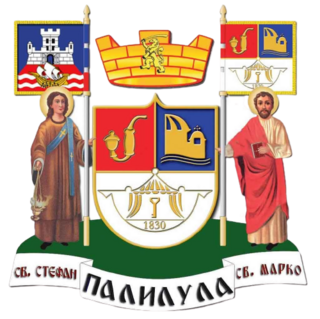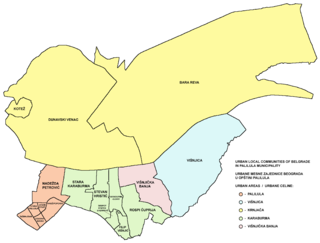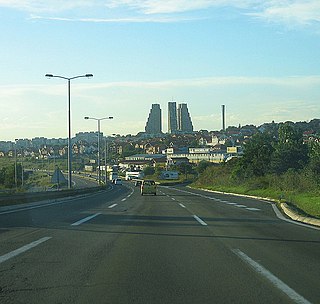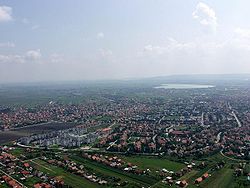This article deals with the system of transport in Belgrade, both public and private.

Palilula is a municipality of the city of Belgrade. It has the largest area of all municipalities of Belgrade. The core of Palilula is close to the center of the city, but the municipality also includes sparsely populated land left of the Danube.

Ovča is a suburban settlement of Belgrade, the capital of Serbia. It is located to the northeast of the city, in the municipality of Palilula.
Mika Alas is an urban neighborhood of Belgrade, the capital of Serbia. It is located in Belgrade's municipality of Palilula.

Krnjača is an urban neighborhood of Belgrade, the capital of Serbia. It is located in Belgrade's municipality of Palilula.

Pančevački Rit is a small geographical area in south-western Banat, Serbia. It is situated between the rivers Danube and Tamiš, in Belgrade's municipality of Palilula.
Dunavski Venac is an urban neighborhood of Belgrade, the capital of Serbia. It is located in Belgrade's municipality of Palilula, geographically located in Banat.

Reva is an urban neighborhood of Belgrade, the capital of Serbia. It is a sub-neighborhood of Krnjača and is located in Belgrade's municipality of Palilula. According to the 2011 census, it had a population of 2,522.
Glogonjski Rit is a suburban settlement of Belgrade, the capital of Serbia. It is located in the Belgrade's municipality of Palilula.

Kovilovo is a suburban settlement of Belgrade, the capital of Serbia. It is located in the Belgrade's municipality of Palilula.
Sebeš is a river, bog and a suburban settlement of Belgrade, the capital of Serbia. All three are located in the Belgrade's municipality of Palilula.
Padinska Skela, or colloquially Padinjak (Падињак), is a suburban settlement of Belgrade, the capital of Serbia. It is located in the Belgrade's municipality of Palilula.
Čaplja is a projected river island (ada) in Serbia, on the left bank of the Danube. According to the General Urbanistic Plan (GUP) of Belgrade, it will be formed in Belgrade's municipality of Palilula.

Marinkova Bara is an urban neighborhood of Belgrade, the capital of Serbia. It is located in the municipality of Voždovac.

Konjarnik is an urban neighborhood of Belgrade, the capital of Serbia. It is divided between Belgrade's municipalities of Voždovac and Zvezdara. As a large neighborhood, it has several sub-neighborhoods of its own, including Denkova Bašta, Učiteljsko Naselje and Rudo.

BG Voz is an urban rail system that serves the city of Belgrade, Serbia. It is operated by the public transit corporation GSP Belgrade and is a part of the integrated BusPlus system.

Veliko Blato is a lake in Krnjača, an urban neighborhood of Belgrade, Serbia. It is located in the municipality of Palilula.
The Vizelj is a short channeled river in north-central Serbia, the left tributary to the Danube. During its entire flow it runs through the suburban section of Belgrade, on the territory of municipality of Palilula.

Beljarica is a wetland in the Danube valley in Belgrade, the capital of Serbia. Since 2013, it is in the process of becoming protected area. Due to the abundant wildlife and undisturbed nature, though being close to downtown Belgrade, it has been nicknamed "Belgrade's Amazonia". With Gornje Podunavlje and Kovilj-Petrovaradin Marshes, both of which have already been declared special nature reserves, Beljarica is among the largest flood zones in Serbia.














